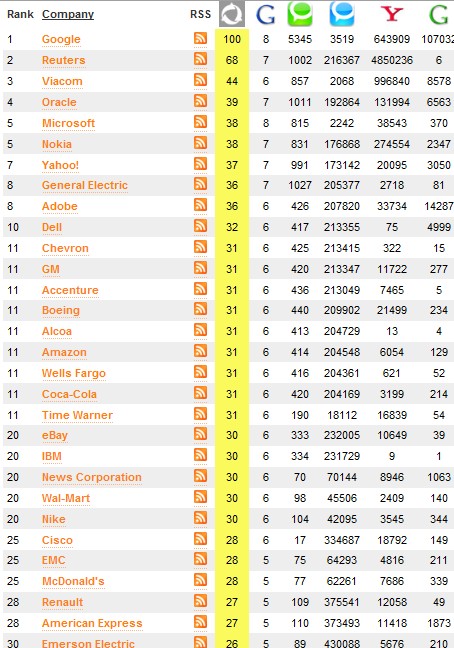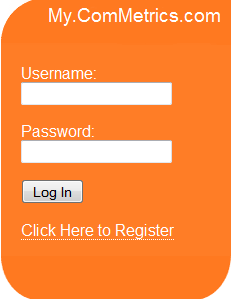 After publishing the 2009 FT ComMetrics Blog Index, which ranks FT Global 500 and Fortune 500 companies’ corporate blogs, some readers came forward asking for some tips on how to improve one’s ranking and statistics.
After publishing the 2009 FT ComMetrics Blog Index, which ranks FT Global 500 and Fortune 500 companies’ corporate blogs, some readers came forward asking for some tips on how to improve one’s ranking and statistics.
Can we help? Definitely! We have developed some best practices, as outlined below in a series of posts.
Today we release the first two installments of these tips and lessons, the first of which can be read here:
1) Lessons 1 – 4: Starting your blogging off on the right foot (2009-06-03)
The next set will be published July 8:
3) Lessons 8 – 11: Whatever domain, home you choose – beware
4) Lessons 12 – 13: Getting the basic SEO issues right
The final set will come your way August 12:
5) Lessons 14 – 17: Authenticity and quality are key
6) Lessons 18 – 20: Improving blogging effectiveness
To make sure that you don’t miss any of these upcoming posts, just leave your e-mail here:
Lesson 5: Describe the value-potential for your proposed target audience
Defining the type of blog one is after (Lesson 2), target audience one is aiming for (Lesson 3), as well as the focus of two-thirds of the content on your blog (Lesson 4) are all crucial first steps.
Here the focus is on why anybody would want to read your blog, instead of going to the beach or getting another customer to sign on the dotted line.
- Google may have a blog I need to read because it provides 80 percent of my webpage’s search traffic – if it changes something in its technology that will affect my blog’s traffic I need to know right away.
The issue is also whether one reads the blog for entertainment value (e.g., a blog about one’s favorite online game, gossip blog about sitcom TV show, etc.), professional purposes (e.g., keeping abreast of the latest developments in one’s industry) or some other reason. A corporate blog can probably serve either group. Nevertheless, the key question is how it will help you sell more product or build the corporation’s reputation, visibility, brand and trust. Jot down a few sentences and see if your thoughts make sense to other team members.
Lesson 6 – define which strategic objectives can be supported by the blog
Make clear whether the blog is supposed to support sales or help build greater visibility for the brand.
- GM is trying to make sure that no unsubstantiated rumors make the news, which serves the sole purpose of defusing rumors and correcting misstated facts as quickly as possible.
GM’s ‘tell it straight’ blog was intended to make sure that the world, including customers, taxpayers and investors, got the facts about its business negotiations before filing for bankruptcy protection in the US. Its primary focus is helping the firm survive in one form or another by getting the company’s viewpoint across. Most people would agree it has succeeded.
Lesson 7: Define which actionable metrics will be applied based on rules 1-6

To see how well your blog measures with these actionable metrics register your blog here:
My.ComMetrics.com – benchmarking your blog – sign up for FREE
An example of actionable metrics is when getting information that triggers a decision or action, such as finding out that one train to Point B departs at 8:05 and the next at 9:05. Depending on which train is chosen, one must leave home at a certain time to get to the station in time. The information is the basis on which the user makes a decision and takes action based on that decision. In business, failing to meet sales figures this quarter may result in the company deciding to put its workforce on a shorter work week for next quarter.
Besides following the KISS (Keep It Simple, Stupid) principle, for a blog this means one needs SMART (Specific, Manageable, Actionable, Relevant, Trending) metrics for web and blog analytics. Accordingly, unless a drop in unique visitors last month results in some action to counter this effect why use this metric (Unique visitors come in many guises)? In fact, less traffic on a blog could be worth more in the end – if it’s the right kind of traffic (e.g., people feeling okay to buy product).
These days we tend to have too many metrics that are not used to make choices or decisions that result in actions to remedy the problem (see also Social media – metrics to know and metrics to skip – FAQ #2). Instead, it is smarter to focus on a few indicators that result in actions, depending on the data one gets. Examples are:
- the ComMetrics Footprint (see 2009 FT ComMetrics Blog Index),
the ComMetrics Health Check, and
the ComMetrics Return on Connection.
Composite indicators have their weaknesses but they are widely used for various reasons including, but not limited to, simplifying complex issues.
Okay, now it’s your turn. What techniques you have used in improving blogging effectiveness? What was your most successful “let’s do this and move on” tactic? If you have come close to resolving these challenges smartly, what did you do? Which of the above four strategies is your favorite? Which one do you think is just baloney? It’s okay – be honest. We can take it. Thanks much.
P.S. – Of interest to you would be our next set of ropes to skip: 3) Lessons 8 – 11: Whatever domain or home you choose – beware (2009-07-08).
Pingback: Urs E. Gattiker
Pingback: Urs E. Gattiker
Pingback: Increasing blogging effectiveness: Step 6
Pingback: Increasing blogging effectiveness: Step 4 - best metrics, social media analytics, blog, corporate benchmark, FT ComMetrics Blog Index, social media analytics - ComMetrics: social media monitoring => best practice
Pingback: 3 golden rules for social media marketing
Pingback: Increasing blogging effectiveness: Step 5 - Today we release the last two installments of these tips and lessons, fifth post, commitment authenticity and managing cultural differences, Lesson 14 Commit to regularly posting during mid-week, several writers
Pingback: ComMetrics weekly review: Friendfeed to Berlusconi - Very useful links OECD to Twitter Google via Coca-Cola, Very useful links Qwerty to WEF, Very useful links Facebook to Morgan Stanley, Very useful links White House to Adobe, Very useful links Nikon to